目录
参考:https://www.bilibili.com/video/BV1zJ411R7uQ/?vd_source=c75e68fd099206ad9761f2134ce79ce2
我的是直接实战演示,大家想要知道概念什么的话可以参考一下上面的博客。
下面的内容写的可能比较混乱

通过stream获取集合中指定数据:
package com.jdktest01.day02;
import java.util.ArrayList;
import java.util.Collections;
/**
* @author a1002
*/
public class StreamTest01 {
public static void main(String[] args) {
ArrayList<String> list = new ArrayList<>();
Collections.addAll(list, "张无忌", "周芷若", "赵敏", "张三丰", "师太", "韦小宝", "康熙");
ArrayList<String> zhangList = new ArrayList<>();
list.stream()
.filter((s) -> {
return s.startsWith("张");
})
.filter((s) -> {
return s.length() == 3;
})
//遍历
.forEach((s) -> {
System.out.println(s);
System.out.println(s.length());
//添加到集合中
zhangList.add(s);
});
System.out.println("=========================");
//拿到所有姓张的且长度为3的
//集合遍历
System.out.println(zhangList);
System.out.println("---------------------------");
list.forEach(System.out::println);
}
}
获取流:
package com.jdktest01.day02;
import java.util.*;
import java.util.stream.Stream;
/**
* @author a1002
*/
public class StreamTest03 {
public static void main(String[] args) {
// 方式1 : 根据Collection获取流
// Collection接口中有一个默认的方法: default Stream<E> stream()
List<String> list = new ArrayList<>();
Stream<String> stream1 = list.stream();
Set<String> set = new HashSet<>();
Stream<String> stream2 = set.stream();
Map<String, String> map = new HashMap<>();
Stream<String> stream3 = map.keySet().stream();
Stream<String> stream4 = map.values().stream();
Stream<Map.Entry<String, String>> stream5 = map.entrySet().stream();
// 方式2 : Stream中的静态方法of获取流
// static<T> Stream<T> of(T... values)
Stream<String> stream6 = Stream.of("aa", "bb", "cc");
String[] strs = {"aa", "bb", "cc"};
Stream<String> stream7 = Stream.of(strs);
// 基本数据类型的数组行不行?不行的,会将整个数组看做一个元素进行操作.
int[] arr = {11, 22, 33};
Stream<int[]> stream8 = Stream.of(arr);
}
}
stream流中的foreach方法:
package com.jdktest01.day02;
import java.util.ArrayList;
import java.util.Collections;
import java.util.List;
/**
* @author a1002
*/
public class StreamTest04 {
public static void main(String[] args) {
List<String> one = new ArrayList<>();
Collections.addAll(one, "迪丽热巴", "周雨彤", "马思纯", "肖战", "老子", "庄子");
one.stream().forEach((String str) -> {
System.out.println(str);
});
System.out.println("-------------------------");
one.stream().forEach(System.out::println);
System.out.println("-------------------------");
one.forEach(System.out::println);
}
}
stream流中的filter方法:
//过滤
List<String> one = new ArrayList<>();
Collections.addAll(one, "迪丽热巴", "周雨彤", "马思纯", "肖战", "老子", "庄子");
one.stream().filter((String s) -> {
return s.length() == 3;
}).forEach(System.out::println);
System.out.println("---------------------");
//简化
one.stream().filter(s -> s.length() == 3).forEach(System.out::println);
System.out.println("---------------------");stream流中的limit方法:
//限制输出数据数量
one.stream()
.limit(3)
.forEach(System.out::println);stream流中的skip方法:
List<String> one = new ArrayList<>();
Collections.addAll(one, "迪丽热巴", "周雨彤", "马思纯", "肖战", "老子", "庄子");
//跳过指定的前两个数据
one.stream()
.skip(2)
.forEach(System.out::println);从下面可以看到skip指定类型是long,所以不能指定跳过某一个String。

Stream流中的map方法:
@Test
public void testMap() {
//Map可以将一种类型的流转为另一种类型的流
Stream<String> original = Stream.of("11", "22", "33");
//将stream流中的字符串转为Integer
//参数就是你原本的类型
// original.map((String s) -> {
// return Integer.parseInt(s);
// });
System.out.println("---------------------");
//简化
// original.map(s -> Integer.parseInt(s)).forEach(System.out::println);
//再简化
original.map(Integer::parseInt).forEach(System.out::println);
}stream流中的sorted方法:
//排序
@Test
public void testSorted() {
// sorted(): 根据元素的自然顺序排序
// sorted(Comparator<? super T> comparator): 根据比较器指定的规则排序
Stream<Integer> stream = Stream.of(33, 22, 11, 55);
//升序
stream.sorted().forEach(System.out::println);
System.out.println("------------------------");
//降序
stream.sorted((Integer i1, Integer i2) -> {
return i2 - i1;
}).forEach(System.out::println);
System.out.println("------------------------");
//降序简化
stream.sorted((i1, i2) -> i2 - i1).forEach(System.out::println);
}Stream流中的distinct方法:
// distinct对自定义对象去除重复
@Test
public void testDistinct() {
Stream<Integer> stream = Stream.of(33, 22, 11, 55, 88, 33, 22, 22, 88, 34, 23);
stream.distinct().forEach(System.out::println);
Stream<String> stream1 = Stream.of("a", "b", "c", "a", "b");
stream1.distinct().forEach(System.out::println);
}对Person类中的equals和hashcode方法进行重写,stream中的数据再运行时就会被去重
@Test
public void testDistinct01() {
Stream<Person> stream = Stream.of(
new Person("貂蝉", 18),
new Person("杨玉环", 20),
new Person("杨玉环", 20),
new Person("西施", 16),
new Person("西施", 16),
new Person("王昭君", 25)
);
stream.distinct().forEach(System.out::println);
}重写Person类中的equals和hashcode方法:
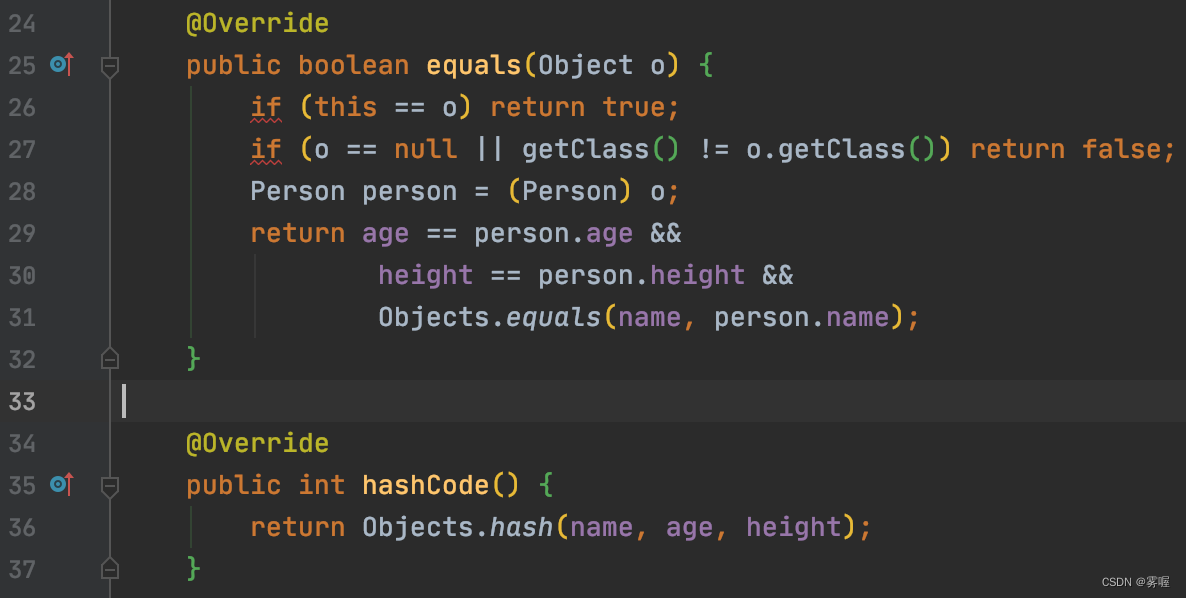
运行结果:

Stream流的match方法:
@Test
public void testMatch() {
Stream<Integer> stream = Stream.of(33, 22, 11, 55, 88, 33, 22, 22, 88, 34, 23);
//allMatch需要所有的元素都满足才返回true
//allMatch:匹配所有元素,所有的元素都需要满足条件
boolean b = stream.allMatch((Integer i) -> {
return i > 22;
});
System.out.println(b);
Stream<Integer> stream1 = Stream.of(11, 2, 4, 5);
//allMatch需要所有的元素都满足才返回true
boolean b1 = stream1.allMatch((Integer i) -> {
return i > 0;
});
System.out.println(b1);
//anyMatch: 匹配某个元素,只要有其中一个元素满足条件即可
Stream<Integer> stream3 = Stream.of(33, 22, 11, 55, 88, 33, 22, 22, 88, 34, 23);
boolean b2 = stream3.anyMatch((Integer i) -> {
return i > 22;
});
System.out.println(b2);
//noneMatch: 匹配所有元素,所有元素都不满足条件
Stream<Integer> stream4 = Stream.of(33, 22, 11, 55, 88, 33, 22, 22, 88, 34, 23);
boolean b3 = stream4.noneMatch(i -> i > 0);
System.out.println(b3);
}Stream流的find方法:
@Test
public void testFind() {
Stream<Integer> stream = Stream.of(33, 22, 11, 55, 88, 33, 22, 22, 88, 34, 23);
Optional<Integer> optional = stream.findFirst();
System.out.println(optional.get());
}Stream流中的max和min方法:
@Test
public void testMax() {
//获取最大值
Stream<Integer> stream = Stream.of(33, 22, 11, 55, 88, 33, 22, 22, 88, 34, 23);
Optional<Integer> max = stream.max((o1, o2) -> o1 - o2);
System.out.println(max.get());
//获取最小值
Optional<Integer> min = Stream.of(5, 6, 3, 1).min((o1, o2) -> o1 - o2);
System.out.println(min.get());
}输出:

Stream流的reduce方法:
// T reduce(T identity, BinaryOperator<T> accumulator);
// T identity: 默认值
// BinaryOperator<T> accumulator: 对数据进行处理的方式
// reduce如何执行?
// 第一次, 将默认值赋值给x, 取出集合第一元素赋值给y
// 第二次, 将上一次返回的结果赋值x, 取出集合第二元素赋值给y
// 第三次, 将上一次返回的结果赋值x, 取出集合第三元素赋值给y
// 第四次, 将上一次返回的结果赋值x, 取出集合第四元素赋值给y
//以此类推
@Test
public void testReduce() {
int reduce = Stream.of(4, 5, 7, 2, 9).reduce(0, (x, y) -> {
System.out.println("x = " + x + " y = " + y);
return x + y;
});
System.out.println(reduce);
}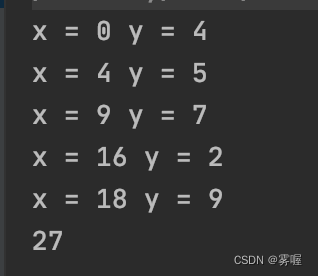
有点类似于js的特性。
27即为数据和。
找出最大值:
int max = Stream.of(4, 5, 7, 2, 9).reduce(0, (x, y) -> {
return x > y ? x : y;
});
System.out.println(max);对stream里面封装对象里的某一个数据进行求和:
@Test
public void testReduce01() {
Integer totalAge = Stream.of(
new Person("刘德华", 58),
new Person("张学友", 56),
new Person("郭富城", 54),
new Person("黎明", 52))
.map((p) -> {
return p.getAge();
}).reduce(0, (x, y) -> {
return x + y;
});
System.out.println("totalAge= " + totalAge);
}求stream内封装对象某一个属性最大值
Integer maxAge = Stream.of(
new Person("刘德华", 58),
new Person("张学友", 56),
new Person("郭富城", 54),
new Person("黎明", 52))
.map(p -> p.getAge())
.reduce(0, Math::max);
System.out.println("maxAge=" + maxAge);统计某一个元素出现的次数:
//统计a出现的次数
Integer count = Stream.of("a", "b", "a", "d", "a")
.map(s -> {
if (s == "a") {
return 1;
} else {
return 0;
}
})
.reduce(0, Integer::sum);
System.out.println("count=" + count);Stream的concat方法:
@Test
public void testContact() {
Stream<String> streamA = Stream.of("张三");
Stream<String> streamB = Stream.of("李四");
//合并成一个流
Stream<String> newStream = Stream.concat(streamA, streamB);
// 注意:合并流之后,不能操作之前的流啦.
// streamA.forEach(System.out::println);
newStream.forEach(System.out::println);
}Stream小练习:
public static void main(String[] args) {
// 第一个队伍
List<String> one = new ArrayList<>();
Collections.addAll(one, "迪丽热巴", "宋远桥", "苏星河", "老子", "庄子", "孙子", "洪七公");
// 第二个队伍
List<String> two = new ArrayList<>();
Collections.addAll(two, "古力娜扎", "张无忌", "张三丰", "赵丽颖", "张二狗", "张天爱", "张三");
// 1.第一个队伍只要名字为3个字的成员姓名;
System.out.println("1.第一个队伍只要名字为3个字的成员姓名-----------------------");
one.stream().filter(s -> s.length() == 3).forEach(System.out::println);
// 2.第一个队伍筛选之后只要前3个人;
System.out.println("2.第一个队伍筛选之后只要前3个人-----------------------");
one.stream().limit(3).forEach(System.out::println);
// 3.第二个队伍只要姓张的成员姓名;
System.out.println("3.第二个队伍只要姓张的成员姓名-----------------------");
two.stream().filter(s -> s.startsWith("张")).forEach(System.out::println);
// 4.第二个队伍筛选之后不要前2个人;
System.out.println("4.第二个队伍筛选之后不要前2个人-----------------------");
two.stream().skip(2).forEach(System.out::println);
// 5.将两个队伍合并为一个队伍;
System.out.println("5.将两个队伍合并为一个队伍-----------------------");
Stream<String> newStream = Stream.concat(one.stream(), two.stream());
newStream.forEach(System.out::println);
// 6.根据姓名创建`Person`对象;
// 7.打印整个队伍的Person对象信息。
System.out.println("6.根据姓名创建`Person`对象-----------------------");
System.out.println("7.打印整个队伍的Person对象信息-----------------------");
Stream<String> StreamAB = Stream.concat(one.stream(), two.stream());
StreamAB.map(Person::new).forEach(System.out::println);
}输出:
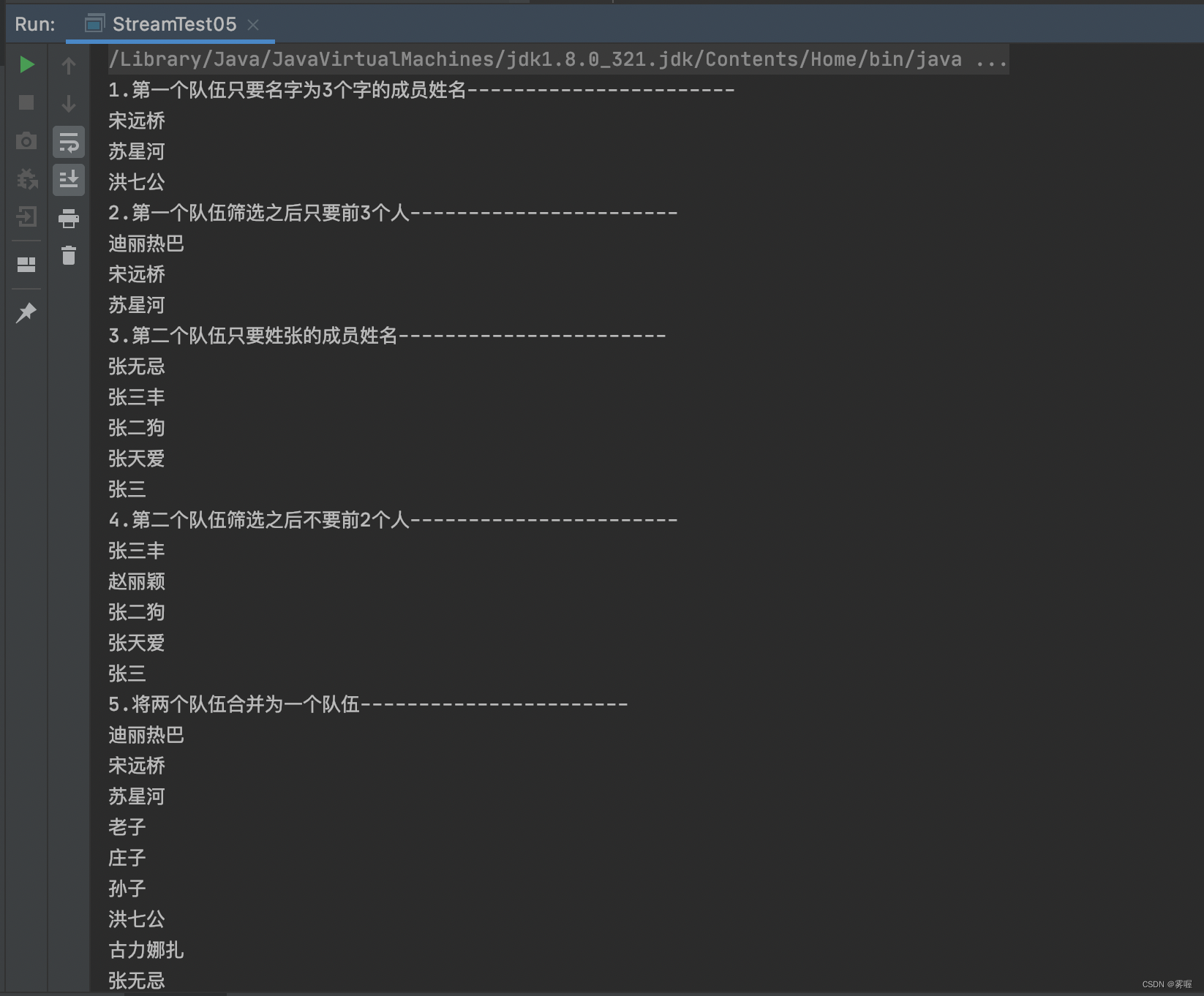

将流中的数据收集到集合中:
//将流中的数据收集到集合中
@Test
public void testStreamToCollection() {
Stream<String> stream = Stream.of("aa", "bb", "cc", "aa");
//将流中的数据收集到集合中
//collection收集流中的数据到集合中
// List<String> list = stream.collect(Collectors.toList());
// System.out.println("list = " + list);
// Set<String> set = stream.collect(Collectors.toSet());
// System.out.println("set = " + set);
HashSet<String> hashSet = stream.collect(Collectors.toCollection(HashSet::new));
System.out.println("hashset = " + hashSet);
}将流中的数据收集到数组中:
@Test
public void testStreamToArray() {
// 转成Object数组不方便
// Object[] objects = stream.toArray();
// for (Object o : objects) {
// System.out.println("o = " + o);
// }
// String[]
Stream<String> stream = Stream.of("aa", "bb", "cc", "aa");
String[] strings = stream.toArray(String[]::new);
System.out.println("strings = " + Arrays.toString(strings) + ", 长度:" + strings.length);
}对流中数据进行聚合运算:
@Test
public void testStreamToOther() {
Stream<Student> studentStream = Stream.of(
new Student("赵丽颖", 58, 95),
new Student("杨颖", 56, 88),
new Student("迪丽热巴", 56, 99),
new Student("柳岩", 52, 77));
//获取最大值
Optional<Student> max = studentStream.collect(Collectors.maxBy((s1, s2) -> s1.getSocre() - s2.getSocre()));
System.out.println(max.get());
List<Student> max1 = new ArrayList<>();
Collections.addAll(max1, new Student("赵丽颖", 58, 95),
new Student("杨颖", 56, 88),
new Student("迪丽热巴", 56, 99),
new Student("柳岩", 52, 77));
Optional<Student> collect = max1.stream().collect(Collectors.maxBy((s1, s2) -> s1.getSocre() - s2.getSocre()));
System.out.println(collect.get());
//获取最小值
Stream<Student> studentStream1 = Stream.of(
new Student("赵丽颖", 58, 95),
new Student("杨颖", 56, 88),
new Student("迪丽热巴", 56, 99),
new Student("柳岩", 52, 77));
Optional<Student> min = studentStream1.collect(Collectors.maxBy((s1, s2) -> s2.getSocre() - s1.getSocre()));
System.out.println(min.get());
//求总和
Stream<Student> studentStream2 = Stream.of(
new Student("赵丽颖", 58, 95),
new Student("杨颖", 56, 88),
new Student("迪丽热巴", 56, 99),
new Student("柳岩", 52, 77));
Integer sum = studentStream2.collect(Collectors.summingInt(s -> s.getAge()));
System.out.println("sum = " + sum);
// 平均值
Stream<Student> studentStream3 = Stream.of(
new Student("赵丽颖", 58, 95),
new Student("杨颖", 56, 88),
new Student("迪丽热巴", 56, 99),
new Student("柳岩", 52, 77));
// Double avg = studentStream3.collect(Collectors.averagingInt(s -> s.getSocre()));
Double avg = studentStream3.collect(Collectors.averagingInt(Student::getSocre));
System.out.println("平均值: " + avg);
// 统计数量
Stream<Student> studentStream4 = Stream.of(
new Student("赵丽颖", 58, 95),
new Student("杨颖", 56, 88),
new Student("迪丽热巴", 56, 99),
new Student("柳岩", 52, 77));
Long count = studentStream4.collect(Collectors.counting());
System.out.println("统计数量: " + count);
}输出:
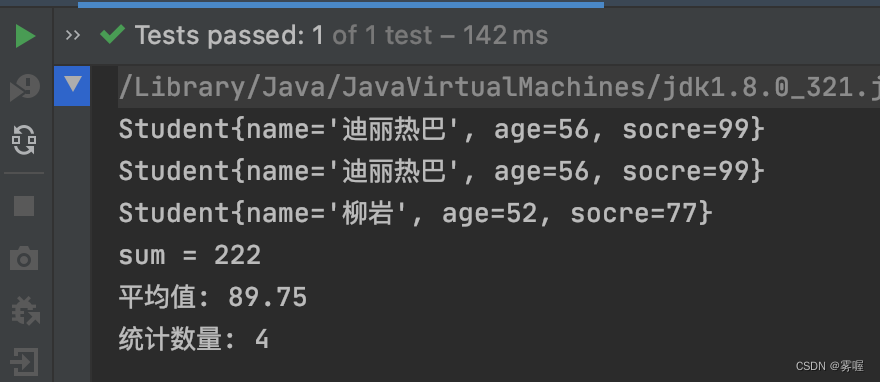
对流中数据进行分组:
@Test
public void testCollectors() {
Stream<Student> studentStream5 = Stream.of(
new Student("赵丽颖", 58, 95),
new Student("杨颖", 56, 88),
new Student("迪丽热巴", 56, 99),
new Student("柳岩", 52, 77));
Map<Integer, List<Student>> map = studentStream5.collect(Collectors.groupingBy((s) -> s.getAge()));
map.forEach((k, v) -> {
System.out.println(k + "::" + v);
});
}输出:

@Test
public void testCollectors01() {
Stream<Student> studentStream5 = Stream.of(
new Student("赵丽颖", 58, 95),
new Student("杨颖", 56, 88),
new Student("迪丽热巴", 56, 99),
new Student("柳岩", 52, 56));
Map<String, List<Student>> map = studentStream5.collect(Collectors.groupingBy((s) -> {
if (s.getSocre() > 60) {
return "及格";
} else {
return "不及格";
}
}));
map.forEach((k, v) -> {
System.out.println(k + "::" + v);
});
}输出:

多级分组:
// 多级分组
@Test
public void testCustomGroup() {
Stream<Student> studentStream = Stream.of(
new Student("赵丽颖", 52, 95),
new Student("杨颖", 56, 88),
new Student("迪丽热巴", 56, 55),
new Student("柳岩", 52, 33));
// 先根据年龄分组,每组中在根据成绩分组
// groupingBy(Function<? super T, ? extends K> classifier, Collector<? super T, A, D> downstream)
Map<Integer, Map<String, List<Student>>> map = studentStream.collect(Collectors.groupingBy(Student::getAge, Collectors.groupingBy((s) -> {
if (s.getSocre() > 60) {
return "及格";
} else {
return "不及格";
}
})));
// 遍历
map.forEach((k, v) -> {
System.out.println(k);
// v还是一个map,再次遍历
v.forEach((k2, v2) -> {
System.out.println("\t" + k2 + " == " + v2);
});
});
}输出:
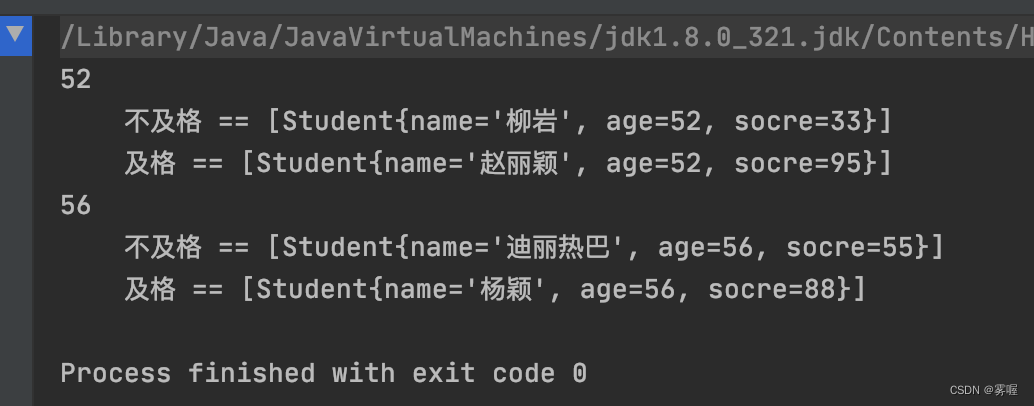
对流中数据进行拼接:
@Test
public void testCollection01() {
Stream<Student> studentStream = Stream.of(
new Student("赵丽颖", 52, 95),
new Student("杨颖", 56, 88),
new Student("迪丽热巴", 56, 55),
new Student("柳岩", 52, 33));
// 根据一个字符串拼接: 赵丽颖__杨颖__迪丽热巴__柳岩
// String names = studentStream.map(Student::getName).collect(Collectors.joining("__"));
String names = studentStream.map(Student::getName).collect(Collectors.joining("___", "+", "-"));
System.out.println(names);
}输出:
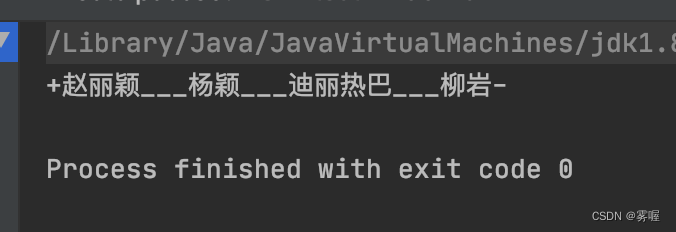
Optional类的基本使用:
@Test
public void test01() {
// 1.创建Optional对象
// of:只能传入一个具体值,不能传入null
// ofNullable: 既可以传入具体值,也可以传入null
// empty: 存入的是null
Optional<String> op1 = Optional.of("凤姐");
// Optional<String> op1 = Optional.of(null);
// Optional<String> op2 = Optional.ofNullable("如花");
// Optional<String> op2 = Optional.ofNullable("如花");
Optional<Object> op3 = Optional.empty();
// 2.isPresent: 判断Optional中是否有具体值, 有值返回true,没有值返回false
// boolean present = op1.isPresent();
// System.out.println("present = " + present);
// 3.get: 获取Optional中的值,如果有值就返回值具体值,没有值就报错
// System.out.println(op3.get());
if (op1.isPresent()) {
System.out.println(op1.get());
} else {
System.out.println("没有值");
}
}@Test
public void test02() {
// Optional<String> userNameO = Optional.of("凤姐");
Optional<String> userNameO = Optional.empty();//name = 如花吗?
// Optional<String> userNameO = Optional.of(" ");//name =
// orElse: 如果Optional中有值,就取出这个值,如果没有值就使用参数指定的值
String name = userNameO.orElse("如花吗?");
System.out.println("name = " + name);
}@Test
public void test04() {
Optional<String> userNameO = Optional.of("凤姐");
// Optional<String> userNameO = Optional.empty();
// 存在做的什么
// ifPresent: 如果有值就调用参数
/*userNameO.ifPresent(s -> {
System.out.println("有值: " + s);
});*/
// ifPresentOrElse: 存在做的什么,不存在做点什么
userNameO.ifPresentOrElse(s -> {
System.out.println("有值: " + s);
}, () -> {
System.out.println("没有值");
});
}就这些吧。
🎉🎉🎉🎉🎉🎉🎉🎉🎉🎉🎉🎉🎉🎉🎉🎉🎉🎉🎉🎉🎉🎉🎉🎉🎉🎉🎉🎉🎉🎉🎉🎉🎉🎉🎉🎉🎉🎉🎉🎉🎉🎉🎉🎉🎉🎉🎉🎉🎉🎉🎉🎉🎉🎉🎉🎉🎉🎉🎉🎉🎉🎉🎉🎉🎉🎉🎉🎉🎉🎉🎉🎉🎉🎉🎉🎉🎉🎉🎉🎉🎉🎉🎉🎉🎉🎉🎉🎉🎉🎉🎉🎉🎉🎉🎉🎉🎉🎉🎉🎉🎉🎉🎉🎉🎉🎉🎉🎉🎉🎉🎉🎉🎉🎉🎉🎉🎉🎉🎉🎉🎉🎉🎉🎉🎉🎉🎉🎉🎉🎉🎉🎉
总结:啊,最近好烦,我的爱车坏掉了,一直没找到时间去修,还有2个事情眼看时间期限临近,再加上上课时无缘无故的老是神游,呜呜呜呜呜呜呜呜,我是真的会谢,还有这学习计划,还有别人在前面跑,我在后面追,还追不上,呜呜呜呜呜呜呜呜,我还在用一个实战项目练手,正项目耽误了不少时间了,呜呜呜呜呜我真的谢了。。。。
还有就是最近迷上了各种算法加密。
还有一些人际关系是真的令我好烦,暂时还找不到好的解决方法,不过有一些是肯定无疑的。唉,跟着自己的感觉走吧,也不赖。























 417
417











 被折叠的 条评论
为什么被折叠?
被折叠的 条评论
为什么被折叠?










